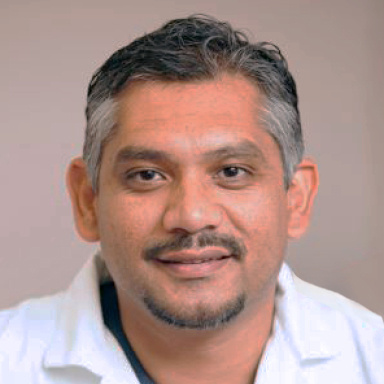Every day our hearts beat about 100 000 times – but some people have an irregular heart rhythm.
Dr Razeen Gopal tells us about the relationship between this condition and strokes.
At the heart of it
‘Think of your heart as a pump that needs to circulate the blood around your body,’ says Dr Razeen Gopal, an electrical cardiologist at Mediclinic Panorama. ‘It can be divided into two sections – the atria and the ventricles – and into two halves – the left and the right.’ The atria pump blood into the ventricles and have a relatively small job to do, while the ventricles pump blood around the body and thus take on most of the work. The atria are therefore thinner and smaller than the muscular ventricles. The right side of the heart pumps blood through the lungs to get oxygen into it and the left side pumps blood around the body, including the brain.
Your heart usually beats between 60 and 80 times a minute but this will increase if the blood needs to move around your body faster, for example during exercise. To allow the chambers to pump in sequence and for your heart to beat faster or slower, it has an electrical timing system. If this system is faulty, you’ll have an abnormal heart rhythm, which is known as arrhythmia.
‘Most people with arrhythmia will experience a combination of the following symptoms: palpitations, shortness of breath, lethargy, dizzy spells or fainting, chest pain or symptoms of a stroke: transient or permanent weakness to one side of the body, and speech or visual impairment,’ says Dr Gopal.
Brain attack
Strokes are often called brain attacks because they affect your brain. So how does your heartbeat affect your risk of having a stroke? ‘There’s a very strong link between atrial fibrillation (AF) – the most common type of arrhythmia – and stroke. An abnormal heart rhythm causes the loss of smooth blood flow in the left atrium, which creates areas of turbulence and currents,’ explains Dr Gopal. ‘These turbulent jets are prone to clot formation, which occur in the left atrium. The clots end up in the left ventricle via the mitral valve, which is the connection between the atrium [the filling chamber] and the ventricle [the pumping chamber]. When this ventricle ejects the blood to the rest of the body, it contains these clots. The major vessels going to the head are the first branches off the aorta [the large artery from the heart], so the clots can obstruct blood flow to the brain.’
What next?
Dr Gopal says AF should be treated as early as possible. For patients who are highly symptomatic, have tried medication and have structually normal hearts, the cryoballoon ablation procedure offers great results.
‘We get access to the heart via the groin,’ explains Dr Gopal. The doctor inserts two catheters through the groin and into the femoral veins. These are then pushed up into the right atrium of the heart. The catheters are positioned in the left atrium through two small holes made in the septum between the two chambers.
A cryoballoon (measuring 2,8cm in diameter) is placed at the base of one of the four pulmonary veins, inflated and cooled to a very low temperature. The cold from the balloon scars the tissue inside your heart, in the location where the irregular beats are triggered. The treated tissue helps to block the ‘faulty’ signals and stop the irregular heartbeat. The process is then repeated on the other three veins.
Signs and symptoms of a stroke
Typically there are three different kinds of strokes, all a result of a disruption in the blood supply to the brain.
Transient ischemic attack (TIA)
Often called a ‘mini-stroke’, this type is less severe than a full-blown stroke and usually lasts a short time (about 10 to 15 minutes). Blood flow is temporarily blocked to part of the brain, causing symptoms similar to an actual stroke. When the blood flows again, the symptoms disappear and usually there is no permanent damage to the brain. A TIA is a warning sign that a stroke may happen soon, which means you must still get to a hospital for a proper checkup.
Ischemic stroke
This is probably the most common type of stroke. About nine out of 10 strokes are ischemic and caused by a blood clot that obstructs a blood vessel in the brain.
Haemmorragic stroke
Haemorrhagic strokes are less common but far more likely to be fatal. They occur when a weakened blood vessel in the brain bursts. The result is bleeding inside the brain that can be difficult to stop.
Did you know? The electrocardiograph (ECG) was invented in 1902 by Dutch physiologist Dr Willem Einthoven. This test is still used to evaluate the heart’s rate and rhythm.
If any of your neurological systems are affected, you could be having a stroke:
Motor – you can’t move your arms
Sensory – numbness
Coordination – you’re falling over your feet
Vision – visual loss or double vision
Speech – unable to speak coherently and appearing confused
If any of these systems are impaired, especially on one side of the body, you should seek urgent medical assistance. When you arrive at the emergency centre, you’ll have either a CT scan or an MRI. A CT scan is quicker to do – it takes less than a minute, while an MRI takes 30 minutes or more and requires full cooperation from the patient.
How do I know if I’m having a stroke?
‘It’s very important that patients go to the nearest emergency centre if they’re unsure whether they’re having a stroke,’ says Dr John Gardiner, a neurologist at Mediclinic Constantiaberg. ‘Rather be told you’re not having a stroke than stay at home wasting time. We doctors don’t mind false alarms, because at the end of the day it’s much better than being too late with treatment.’
Doctors 1


